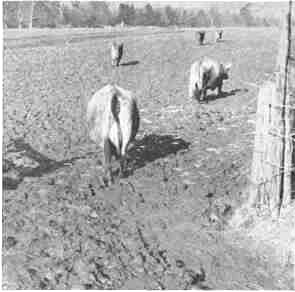
Fertility farming—building the fertility of the soil simultaneously with cropping it—has not been popular, especially in official circles, because, since 1939 maximum production at any price has been official policy. It has mattered little that maximum production of chemically-boosted crops has resulted in diminishing fertility for both the soil and the animal, and an increase in degenerative diseases for the ultimate human consumer. The farmer who has dared to put his future soil-fertility on an equal level of importance with productivity has been in perpetual danger of supervision or dispossession by the Agricultural Committees.
Now real efficiency is at last officially permitted. Production is at last beginning, in official circles, to be related to the cost of achieving it; and soil fertility can now once more become a paramount consideration of good farming.
In this chapter I have described the rotation which lends itself admirably to my system of dependence on silage supported by kale in the winter, and entirely on the herbal ley in the summer. This also enables one to gain maximum soil-fertility at minimum cost by using the cows as dung-spreaders as well as silage-carters and converters.
I am using this rotation in reclaiming old worn-out pastures on my present farm.

9. The short legs of an orthodox show winner—are not ideal for keeping the udder out of the mud
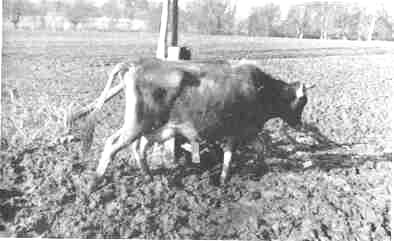
10. The longer legs of Polden Chocolate Cake keep the udder clean. It may be suggested that the long-legged cow is not the best milker. Polden Chocolate Cake gave 8,800 lb. 5.73% B.F. 1st calf--almost the same as Polden Haughty Hetty with her 1st calf (see plate 21)
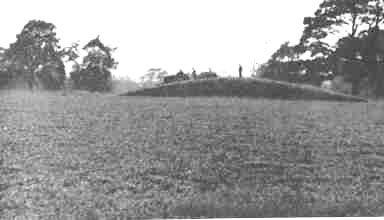
11. A silage heap in the distance and young kale in the foreground
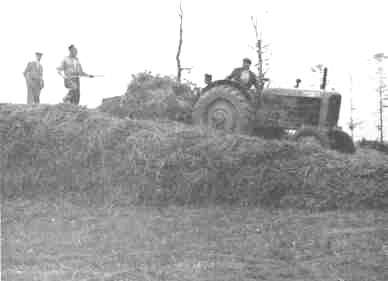
12. A close-up of the same heap as plate 11
In the first year, one end of the field is ploughed or rotavated in the spring or early summer, and worked periodically to get it clean and start the decomposition of the old turf.
In June or early July, into the broken section of the pasture, Thousand-headed kale is sown with a corn drill in rows seven inches apart. The roller follows the drill and no further treatment is given to the kale. It thrives on the decaying turf and produces a leafy plant of kale which is easily grazed behind an electric fence.
The silage heap is made just over on the unploughed portion of the pasture so that the cows may help themselves to silage and kale behind the electric fence—lying back on to the old pasture.
Kale sown on upchurned old turf is ideal for strip-grazing because the turf prevents the soil from becoming too muddy in the winter.
In the second spring, the kale ground is disced or rotavated and sown with oats and vetches, undersown with a herbal ley mixture or sown direct with the ley after cutting the oats and vetches for silage. Another piece of the pasture is broken up and sown to Thousand-headed kale.
The silage heap moves down the field, once more adjoining the kale section.
In the autumn a second silage heap is made from the oats and vetches sown on the first section of the field, leaving the ley underneath for grazing and/or silage in the following spring.
In the third spring we have the herbal ley on the first section, which may be grazed early and then mown to make a silage heap on the old section of the field. The second section which was kale is disced and sown to oats and vetches, and a fourth section is broken for kale. The silage heap is moved down once more on to the old unbroken pasture.
In the fourth spring the second section adds to the area of ley available for grazing and silage. The third section, kale stubble, is disced or rotavated and sown to oats and vetches, undersown or aftersown with a ley, and the fourth section is broken for kale.
This process is continued until the whole field has been broken and sown down to a good herbal ley. In the last year the silage heap will have to be made on one of the new ley sections and the oats and vetches section, which is then the last but one section in the field, is sown immediately after the oats and vetches are cut and gathered for silage, to a winter rye or other winter green grazing crop, undersown with ley if early enough in the autumn (i.e. early September), or to be sown down direct with the last piece from which the kale has been grazed, in the spring.
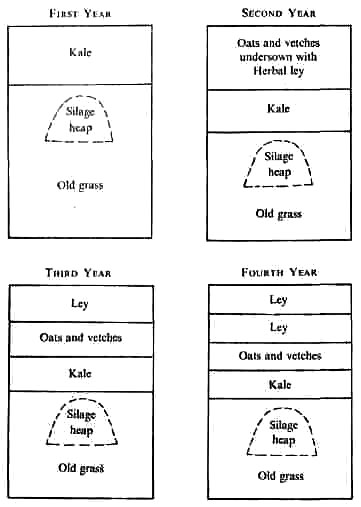
The immense amount of fertility built into the soil by this system comes in a number of ways.
Firstly, everything grown in the field is fed on the field, so that the field grows its own sustenance, passed through the cows, and dunged back rich in nitrogen, potash, and phosphates, and the trace elements derived from the subsoil of adjoining fields brought up by the herbal ley from which the silage was made. When the new ley sections of the field are also going into the silage on the field itself—then the field begins to regenerate its own fertility from its own subsoil (i.e. minerals and trace elements brought up by the deep-rooting herbs of the ley).
If possible each section of the field should be subsoiled either before the kale is sown or before the oats and vetches are sown. In this way the subsoil is opened up ready for the herbal ley which follows the oats and vetches.
Secondly, there are few crops better than oats and vetches for putting nitrogen into the soil. And this is free nitrogen gathered from the atmosphere by the nitrifying bacteria of the vetches—organic nitrogen—the kind which is best for the young ley which is to follow.
You will have no difficulties in establishing a ley from old pasture where a kale crop and an oat and vetch crop have intervened. The decaying turf has released, by means of the organic acids of decay bringing them into solution, the unavailable minerals which are present in every soil if only they can be released. As I have said elsewhere, given a few leaves of organic matter for anchorage, sustenance, and the dissolution of a minute portion of the rock, nature can grow a vigorous and healthy plant actually on a rock. The criterion of crop growing in any part of the world is nothing more complex than the presence of a little moisture-holding, nutrient-releasing organic matter. In other words the secret of establishing a ley is biological and not chemical. I have explained in more detail in another chapter (Making a Ley with a Mower) how a perfect ley can be established on a mineral- and lime-deficient soil without the use of any synthetic sustenance.
This, then, is the third free source of fertility inherent in this system.
Fourthly, the strip-grazing of the kale concentrates an even surface dressing of dung on to the kale section each year, applied far more thoroughly and evenly than by hand or machine, and effectively incorporated into the top soil by the trampling feet of the cattle themselves. A valuable interval of time intervenes for the action of rain, atmosphere and soil organisms to commence their processing of the dung before it is churned into a rich seed-bed by the disc harrow or rotary hoe.
Fifthly, and perhaps the real centre-piece in this jig-saw pattern of fertility, is the self-service silage heap, radiating from all angles of the heap the rich manurial value which the cow is continually depositing as she feeds at the heap, and moves to and from the heap in her journeys to the grass to lie and cud, or to the kale to stand and graze. As the silage heap moves across the field each year this concentration of fertility gradually covers the whole field. But as the greatest fertility is always at the site of the heap, additional value may be obtained by shifting the heap from side to side of the field according to where the less fertile areas of the field may be.
Two additions to this self-feeding, self-fertilizing programme —one for the heifers and dry stock and one for the milking herd— are the incorporation into the system of the self-feeding of straw and hay.
A system I first saw deliberately practised in Eire in 1946 is the building of a hay or straw stack in a field in which cattle are to be wintered, and allowing the cattle to pull out the hay or straw as they need it. By this method they gather from the hay or straw both food and shelter. The small residue, trampled under and dunged upon, is forked up into a compost heap when the cattle have finished.
With cattle that are not in milk, where unlimited straw may be allowed, the combination of this straw-feeding system with the
self-fed silage and kale provides a way of using straw and increasing the amount of manure available to spread on the field. One snag, however, is that very little of the straw is eaten whenever there is good silage available, and this even applies to hay. It seems that even the best hay is less palatable than good silage and kale.
WEATHERPROOF HAYMAKING
But hay made on tripods is attractive, and is the only hay in my experience which offers any comparison with good silage. If you still hang on to the tradition of hay being an essential part of winter feeding (my cows have had no hay, except for limited experiments, for six years) here is a new way of using it.
An adaptation, combining the tripod principle with the Swedish or Norwegian fence or rack system, makes it possible to allow self-feeding of hay in the field in which it was made. This can be yet another variation of the triple self-feeding field described earlier, making it a fourfold feeding system, i.e. self-feeding of the soil, self-feeding silage, self-feeding kale, and self-feeding hay.
The hay is made from grass cut on the lie-back section of the field (the portion not yet broken) or, as some of the earlier sections of the field are re-established as new leys—from them.
The grass is cut and tedded as for tripod haymaking, and, after a few hours' wilting, swept to either hedge with buckrakes which deposit the hay on a several-stranded wire fence, with the fence set at the same angle as the buckrake to allow the buck-rake to drop the hay on the wire rack or fence.
Further supplies of hay are forked on top of the fence by hand to give a sloping rainproof roof to the hay heaped up on the fence. The free-circulation of air under and around the fence quickly dries the hay, which may be lightly thatched or covered with a plastic or sisalcraft material until ready for use. An electric fence keeps the cows away from the hay until they are allowed free access to help themselves to the fence along the headland of the field.
The fence system of haymaking and feeding is of course developed from my experience of the wonderful hay which is to be had by the use of the tripod system. Where the hay is not to be self-fed and can be stacked or baled from actual tripods, the following system is the one I have used for the past ten years.
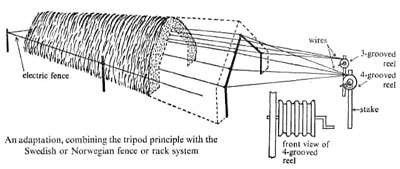
This tripod system means I can plan to make my hay, as soon as the crop is ready, without having to watch my grass growing coarse and losing its feeding value—waiting week after week for the weather to be fine. Before I started weatherproof haymaking ten years ago, as each June came round my life became a perpetual worry about the weather, and my hair began to grow rapidly greyer every year. Now I can make the hay when the grass is at its best; and what is more, it is hay with a 20 per cent protein content, as green as the best dried grass and with a higher food value. Each year now, instead of greyer hair I have greener hay!
We started with straight 7-8 ft. larch- or Douglas-fir poles, making the tripods ourselves, linking them at one end with wire so that they fold together when not in use. When erected upright, we fixed similar, but lighter, horizontal poles, resting about a foot from the ground across the base of each tripod leg. A triangle of wire goes around half-way up to keep the hay out of the centre. This forms the shell of the tripod hut upon which we build the hay. We found, however, that it was much cheaper to buy the ready-made tripods and get the expert instruction of the patentees of the original system. With experienced tripod haymaking it is easy to produce a higher-protein fodder than with any other system, including grass drying; but if the tripods are built badly, it is easier still to produce fodder no better than farmyard manure and even less palatable!
When we start tripod haymaking, each day we cut with the mower as much grass as we can put on tripods the next day; the quantity depends on the number of men available. Two experienced men can build a tripod hut, holding about 5 cwt. of hay, in about twenty minutes. This means that four men, with the aid of a sweep or a buckrake to bring the hay to the tripod, can build at the rate of about 30 cwt. an hour. Allowing for stoppages, four men building tripods, with another man sweeping in the hay, will make a two-ton-an-acre crop at the rate of about five acres a day.
It is important to follow the mower immediately with the type of kick tedder which throws the grass into the air and lets it fall lightly to the ground to wilt. With a crop of about 30 cwt. an acre, what is cut in the morning, provided it is immediately loaded and the weather is good, can be put on to the tripods in the afternoon or evening. But a two-ton an acre, or heavier crop, is best left until the following day before being put on the tripods. Deciding when it is ready to go on the tripods does not require as much experience or skill as deciding when hay, under orthodox systems, is ready to bale or to stack. If it has no external moisture, green wilted grass may usually be put on the tripods within 18-24 hours after cutting, with no risk of damage at all if it is not too tightly built. An experienced tripodder will start to build his tripods much sooner than that.
The aim in building the hut is to get a conical funnel internally, with a thin shell of hay as vertical as possible on the outside. The first 'shelf or foundation of grass is laid on the horizontal poles or triangular wire which form a ledge a foot or so from the base of the tripod. The wall of hay is built up on that, placing the grass on as lightly and loosely as possible. Start by hand, and then throw each small forkful gently on to the shelf, moving round and round as the hut grows. If you have been used to building stacks you'll find it hard to avoid the temptation to pat it down. But you must allow as much air as possible to get in; build so lightly that the hay virtually sits on air. The centre of the tripod must be kept hollow throughout the building operation until the hay has reached about one foot above the apex of the tripod; then, a large round forkful is dropped on, to round off and 'waterproof the top. Tie it down with twine, tying it over the top from the base of one leg to the base of another, if it is likely to be windy.
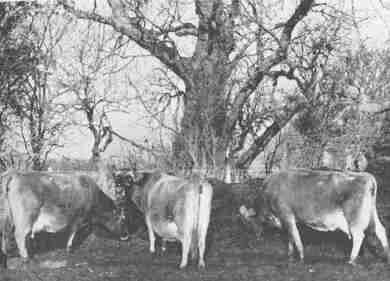
13. Pulling out the silage from the almost sheer face of the heap
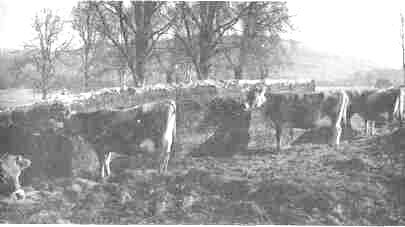
14. Well in to the vertical end of our 1953 self-service silage
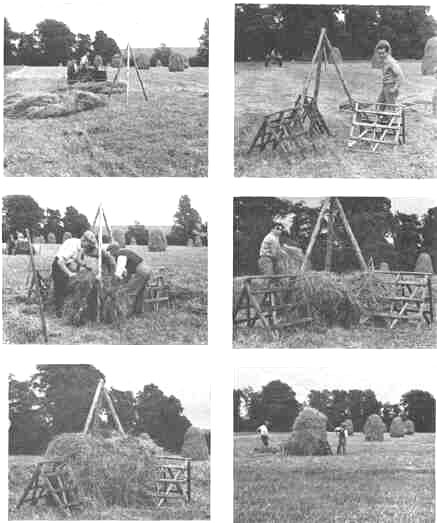
TRIPOD HAYMAKING
15. (1) Sweeping from the swathe to the tripod with a buckrake; (2) The tripod with air vent trestles ready to receive the grass; (3) Building commences; (4) The bottom shelf of hay laid on the wire or crosspiece poles; (5) Built up to the 'shoulder' of the trestles; (6) Ready for the cap. Note the ideal shape for a completed tripod hut in the background of each picture: vertical sides and tall, rather than squat
Once on the tripods the hay is safe for as long as it needs to be left there. It can be self-fed from the tripods by use of the electric fence—rationing out the tripods daily, and running a strand from the main fence around each tripod, to prevent the huts being knocked down as the hay is pulled off by the cows.
Alternatively, sweep or buckrake the tripod hut complete to the baler or stack elevator, or move from hut to hut with a pick-up baler.
The finer points of weatherproof haymaking must be learned from the tripod manufacturers themselves, or from one of the increasing number of farmers who have said good-bye to haymaking worries and invested in this weatherproof system. If you have never tried tripod haymaking yourself, I do urge you to go and see some this year and bring some of the green, high-protein hay back with you for your cows to try. I am sure you will never make hay the worrying way again.
NEXT